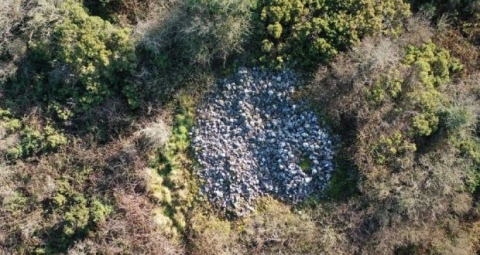Historic discovery of Cairn in County Laois, Ireland

Ireland is well known for its prehistoric manmade megalithic sites used as burial monuments. There is a significant variety to the 1,600 or so megaliths thought to be remaining in Ireland. These include Cairns which have been and are used for a broad variety of purposes, such as burial memorials; for ceremonial purposes, sometimes relating to astronomy; to mark trails and as an integral part of a burial mound or site. Many have been destroyed over the years, with the large stones used in their construction being later used for other purposes. It is also the case that more megalithic sites, including cairns continue to be found.
One such is the recently discovered cairn on the summit of Coolnacarrick Hill, County Laois (Irish: Cúil na Carraige, Contae Laoise). The cairn was located by lecturer Gerry Moloney and product designer Shane McGrath, two non-professional archaeologists from County Kildare (Irish: Contae Chill Dara). Having first looked at imagery from Google Earth they spent hours cutting through dense gorse, briars and other scrub on the side of Coolnacarrick Hill, to reach the location and confirmed the cairn.
At this stage the age of the cairn is not known. However, many date back thousands of years. It has now been reported to the National Monuments Service of Ireland (NMSI). Extensive research and investigation will be required to ascertain the date of the site. Although the site is now heavily surrounded by growth it is located in an area that would have given exceptional views. The cairn is not far from the Rock of Dunamase (Irish: Dún Másc) which is a rocky outcrop 46 metres (151 ft) above a flat plain. This has the ruins of the Dunamase Castle a defensive site dating to the 9th century AD which has views across to the Slieve Bloom Mountains.
Link: Irish newspaper Laois Nationalist.
Image: Overhead view of newly discovered Coolnacarrick Cairn.





